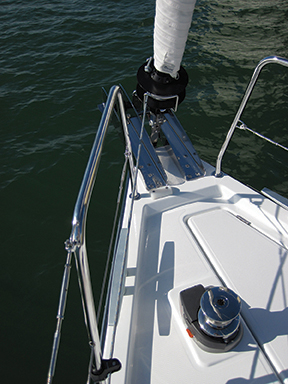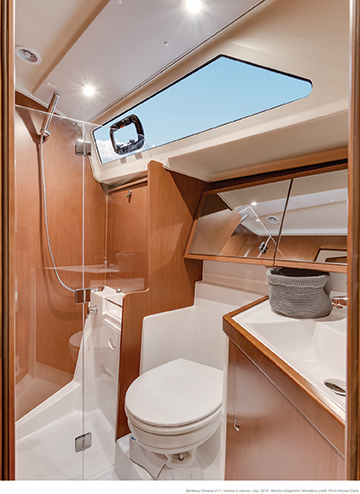The lovely Miami morning that we got to sail the new Beneteau Oceanis 41.1 on Biscayne Bay right after the Strictly Sail Miami show, the sun was warm and bright and the breeze light and building. We motored from Miamarina at Bayside down the narrow channel and under the high bridge on the Rickenbacker Causeway that connects Key Biscayne to the mainland. Under power and with the bow thruster operating, the 41.1 handled easily as we maneuvered from a very tight berth in the marina and then spun her around and put the hammer down.
In the flat water of the channel we got her up to eight knots at 3200 rpms and the feel on the helms remained consistent since the sail drive is far enough forward to reduce the turbulence from prop wash. At 2400 rpms, which is a natural cruising speed, the boat ambled along at 6.5 knots and consumed about half a gallon of diesel an hour. With 53 gallons of diesel in the tank, at this speed the 41.1 will have a powering range of over 400 miles.

Once out in the open water of Biscayne Bay, we hoisted the mainsail, rolled out the 106 percent genoa and hardened up for some close hauled sailing. Onboard with us that morning was Beneteau’s Chris Doscher, who is Sailboat Sales Manager for Beneteau North America. Chris had specced out the boat and had it equipped with laminated performance sails, a double ended or German-style mainsheet, and an adjustable backstay. The sails set beautifully and after we adjusted the sheet cars and added some backstay tension to flatten the main and tightened the headstay, the 41.1 settled into a very nice groove sailing at about 28 degrees to the apparent wind.
The 41.1 is built with the same hull and deck configuration as the original Oceanis 41 that has been part of the company’s cruising line for the past five years. But, a lot has been changed. The deck is now an infused part, which is significantly lighter than the old deck. The interior has been modified and a lot of weight has been removed from the joinery without damaging the overall quality of the built.
With almost a thousand pounds of weight removed from the hull, the designers Finot-Conq were able to redesign the keels—shoal and standard—to be heavier and to have a lower center of gravity which in turn makes the boat stiffer and faster.

The rig has been modified as well. The mast has been moved aft which allows for a good sized main and a larger slightly overlapping headsail. The boat can be equipped with a self-tacking jib, which will be appreciated by couples sailing on their own. The whole concept of the 41.1 is to make sailing easier and more efficient. The shrouds for the mast are outboard so the headsail trims inside them. This gives you better sheeting angles and accommodates a number of headsail sizes.
In the cockpit, the main sheet runs to both of the twin helms where it is controlled with winches close to the helmsman. On the boat we sailed, Beneteau had installed the optional electric Harken winches, so we could sit at the helm and quickly and effortlessly trim the big sail. With only two cockpit winches, you have to use the line stoppers to control the main sheet or jib sheet on the leeward side of the boat but that is no real inconvenience.
With small headsails, particularly the self tacking jib, you will need a downwind sail of some sort to add the power to make the boat sail well off the wind. The bow roller for the anchors can double as a small sprit where you can tack down a reacher or fit a top down furling device.
All control lines from the mast run aft to line stoppers and winches on either side of the companionway. You can hoist and lower the main, trim the outhaul, adjust the vang and tie in reefs without leaving the cockpit. The main sheet is fixed on the cockpit arch so you never have to worry about the sheet slamming across the cockpit when you tack or jibe. The arch also serves as a rigid attachment point for a canvas dodger and can be integrated into a Bimini top over the helms.

Out on the bay, the sea breeze began to fill in as the land heated up. We sailed the 41.1 through a series of tacks and then fell off to jibe downwind for a while. Eventually, the breeze got up to about 10 knots and we were able to harden up to sail very nicely upwind. The boat has hard chines aft that increase aft cabin volume and improve stability. When we heeled to 12 degrees, we could feel the boat stop heeling and the hull just stayed slightly angled as speed through the water increased.
Forty one feet is a good size for a couple who often sail on their own. The cockpit is ergonomically well laid out and all sheets and lines are accessible. With performance sails and rigging, the new stiffer hull and keel design and the already proven hull design, the Oceanis 41.1 is a pleasure to sail.
LIVING ABOARD
By modern standards, 41 feet is no longer a large cruising boat as it would have been a generation ago. But it is still a great size for a couple or small family who want to cruise together whether that be across the bay or around the world.
The new Oceanis 41.1, with deck and interior design by Nauta Design, feels very spacious and well proportioned when you step aboard. With the stern swim platform folded down, the whole cockpit becomes a kind of patio area with plenty of places to sit, a large area for water sports and a table that will seat six for a meal.
The side decks are fairly narrow for a boat with almost 14 feet of beam but moving fore and aft along them is not a problem. With the shrouds mounted outboard, you do have to duck under them as you pass the mast. The foredeck is spacious enough to carry a 10-foot dinghy and the chain locker is large enough for two full rodes and their anchors.
The companionway has a Lexan door that can be locked from the inside while still admitting air flow. The door has a raised sill to prevent water from flooding below as required in the CE Cat A Offshore regulations. The companionway has five steps that are shaped to be good underfoot when the boat is heeled over to her normal 12 degrees. The engine compartment is under the companion steps and accessed by lifting the steps and through side hatches in the two aft cabins. The engine room is tight but you can perform all routine maintenance without taking the boat apart.

The 41.1 has four interior options but all four use the same basic saloon plan. The saloon has the galley to port as you descend the stairs. It s a simple L-shaped galley with a large fridge—top and side loading—a two burner propane stove, a microwave in a cabinet and plenty of locker space. While there is no post to hang onto in the galley, there is a safety bar across the stove and the counter has deep fiddles all around that keep water contained and provide handholds.
Across from the galley is the aft or main head, which has a large separate shower stall that will double as a good wet locker when sailing in rain or rough conditions. Oddly, the boat we sailed had a huge mirror on the saloon bulkhead that frames the head. Since sailors are the least vain class of humans we know, the mirror must have been for added light and the illusion of more space. Below the mirror is the liquor cabinet. All told, we found 17 slots for stowing wine bottles. D’accord.

Beneteau Oceanis 41.1 galley
The dinette is U-shaped and will seat four for dinner while another two or three can eat off their laps on the settee to port. The bench in the dinette is long enough to be a good sea berth during passages offshore.

guest cabin
The four variations offered for the 41.1 include a standard three cabin, one head variation that will suite most families or a couple that often sails with friends who are not partners. In this arrangement, the forward berth is on the centerline. The simple variation on this design has the port quarter cabin converted into a store and work room where you can keep all spare parts, tools and much more. This may be where you would install a genset.
The boat also can be built in a two head version that alters the forward cabin to accommodate a small enclosed head without a shower. To make this fit, the double berth has to be angled to port. The two head version can have either two quarter cabins or the storeroom option.

The 41.1 we sailed had the mahogany Alpi veneer that has been so popular in the recent editions of Beneteaus. This synthetic wood has a uniform grain and can be easily replaced if it is ever damaged. Also it never needs refinishing.
With white overheads, and white vinyl cover bulkhead panels, the interior has a somewhat classic look with modern touches. The side windows and overhead hatches add light and the opening ports all around make for adequate ventilation.
The Beneteau Oceanis 41.12 has a base price slightly under $200,000 so in its most basic form it represents a hugely good value. Plus, if you add the performance package—laminated sails, etc—you add only a few thousand to the price and provide yourself with a rig that is fun to sail. The 41.1 is being built in Beneteau’s U.S. facility in Marion, South Carolina by American craftsmen and women to a level of quality that stands up very well when compared to other production boats. Plus the boat sails like a dream.
Beneteau Oceanis 41.1
LOA 40’9”
LOD 39’4”
Beam 13’9”
Draft 9deep) 7’2”
Draft (shoal) 5’7”
Displ. 19,350 lbs.
Sail area 916 sq. ft.
Fuel 53 gals.
Water 63 gals.
Water (option) 87 gals.
Engine, diesel 45-hp












